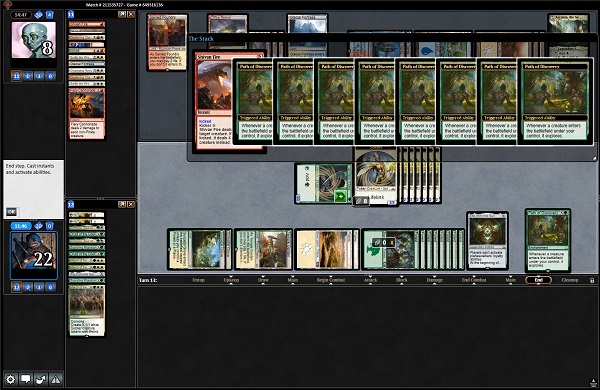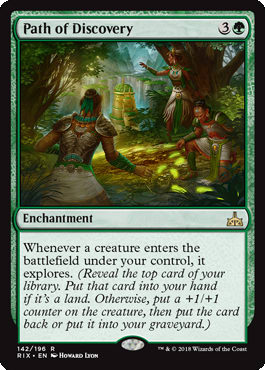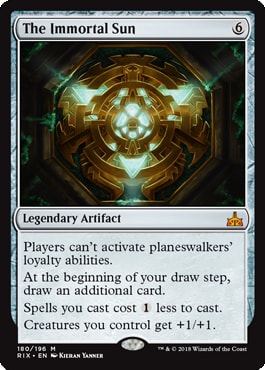Today's deck started from a surprising place.
You probably know from some of my recent articles how much I like the card Experimental Frenzy in Standard. I played a ![]()
![]() Frenzy deck at Grand Prix New Jersey, and have been playing the most boring, soulless, Mono-Red Frenzy deck possible at FNM. I know that
Frenzy deck at Grand Prix New Jersey, and have been playing the most boring, soulless, Mono-Red Frenzy deck possible at FNM. I know that ![]()
![]() Aggro decks are the current belle of Standard's ball... But what about a midrange
Aggro decks are the current belle of Standard's ball... But what about a midrange ![]()
![]() deck with an Experimental Frenzy / Treasure Map engine instead of the hyper fast aggro lists? Might that be an interesting, viable, way to approach the color combination?
deck with an Experimental Frenzy / Treasure Map engine instead of the hyper fast aggro lists? Might that be an interesting, viable, way to approach the color combination?
What if we took a step back for a second and asked ourselves a simple question:
What makes Experimental Frenzy good?
I've heard an interpretation that "it makes every card a cantrip" ... Which isn't not correct.
But then I asked myself... Is there a more direct way of making everything a cantrip? Maybe without some of the limitations of Experimental Frenzy?
I mean, Frenzy is great and all... But when you jam it down early against Control, you do tend to basically discard your hand. Consecutive lands will stall you; and removing large creatures can be inconsistent, even when you theoretically have access to your removal cards.
I hit upon this:
"But Michael," you might be saying to yourself, "Path of Discovery has been legal all year. What makes it potentially good now?"
That would be a great question, dear reader who is asking it. It might be an even better question when we consider the popularity of Tocatli Honor Guard.
People have played Explore strategies, even Golgari decks with 12+ Explore guys. That's not how you break Path of Discovery, I think. What you want is to set up triggers like this:

The trick with this card is to not settle for one-for-one triggers; one cantrip at a time.
Even a non-kicked Saproling Migration starts looking really good with Path of Discovery in play. You either get 4/4 worth of power and toughness across two bodies for 2 mana ( that's Tarmogoyf range), or you draw two extra cards, or you get 3/3 and draw a card (again for two). That's one of the least impressive things you can do with a Path of Discovery in a dedicated deck.
Big token explosions like the one illustrated above become the norm... Once you simply start playing for them. It's not quite a combo deck, but it can start feeling like one. Your cards are individually powerful (even Path, just with regular creatures), but when you're running on all cylinders, your MTGO opponents are asking to pause a second to take screenshots. Maybe you've hit upon something special.
Path can become a kind of cross between a Tutor effect, a massive source of offensive power, and a legitimate card drawing engine. If you're generating a number of Path triggers all at once, you can often afford to be choosy. Make sure you draw a land, usually (unless you have multiple lands in hand already, for instance)... But think about whether you want to settle for whatever spell just got revealed. You might be able to dig to exactly what you want!
You can put cards into your graveyard, or leave them on top to guarantee the next trigger (and you might to actually draw it).
Path to Discovery | Guilds Standard | Michael Flores
- Creatures (15)
- 1 Venerated Loxodon
- 2 Trostani Discordant
- 4 Druid of the Cowl
- 4 Emmara, Soul of the Accord
- 4 Llanowar Elves
- Instants (6)
- 2 Settle the Wreckage
- 4 March of the Multitudes
- Sorceries (8)
- 4 Flower // Flourish
- 4 Saproling Migration
- Enchantments (7)
- 3 Path of Discovery
- 4 Conclave Tribunal
- Artifacts (2)
- 2 The Immortal Sun
- Lands (22)
- 11 Forest
- 2 Plains
- 1 Arch of Orazca
- 4 Sunpetal Grove
- 4 Temple Garden
- Sideboard (15)
- 1 The Immortal Sun
- 4 Carnage Tyrant
- 1 Path of Discovery
- 4 Wildgrowth Walker
- 3 Lyra Dawnbringer
- 2 Settle the Wreckage
My first draft of this deck played the intuitive eight copies of Jadelight Ranger and Merfolk Branchwalker. I came to realize that what I wanted was just more acceleration and more copies of the big card advantage engines. Relying on the Explore guys made my mana less consistent, but my deck more potentially vulnerable to Tocatli Honor Guard. I've since actually had great success with the above version, across most of the format's matchups.
The first game is often challenging against Control, but the sideboarded games with four copies of Carnage Tyrant have been pretty effortless. You can often present threats other than Carnage Tyrant (Path + anything), a big token maker, or certainly The Immortal Sun; and force a Control player into making inefficient defensive decisions. They have to defend themselves from something at some point, and your big engine cards are all capable of overwhelming the opponent by volume. Control decks that rely on Teferi, Hero of Dominaria to win may get entirely nerfed by The Immortal Sun.
While anyone can theoretically lose to Golgari, that's not a common event with this strategy. Your stuff is both often bigger, and attacks the game on more dimensions. You have power, cards in hand, and tokens all working together. They have medium guys that aren't actually that big, ultimately. You might have to watch out for Find // Finality, but you'll tend to have more material in the matchup where having more material is literally the most important. The Immortal Sun is great against versions with Vivien Reid, Vraska, other Vraska, or Karn; you know, Golgari decks. Just watch out for Assassin's Trophy!
I was ultimately most apprehensive about the new ![]()
![]() Aggro decks, similar to what performed at the PT. I started working on this deck before the PT decks were published, so I initially lived in this happy universe of ignorance where people didn't always have three creatures in play on turn two. It turns out that the deck can hold its own against the
Aggro decks, similar to what performed at the PT. I started working on this deck before the PT decks were published, so I initially lived in this happy universe of ignorance where people didn't always have three creatures in play on turn two. It turns out that the deck can hold its own against the ![]()
![]() boogeymen, and for reasons that ultimately make sense. They are certainly offensively faster than you are. They have a lot of 2/1 action where you have 1/1 or nothing. But you not only have lifelink, but some of the cards auto-beat them in Game 1. Example: Settle the Wreckage. I don't think the matchup is great or anything, but we're at least playing the same format, and they have real problems with my sideboarded Lyra Dawnbringers.
boogeymen, and for reasons that ultimately make sense. They are certainly offensively faster than you are. They have a lot of 2/1 action where you have 1/1 or nothing. But you not only have lifelink, but some of the cards auto-beat them in Game 1. Example: Settle the Wreckage. I don't think the matchup is great or anything, but we're at least playing the same format, and they have real problems with my sideboarded Lyra Dawnbringers.
Ditto on Mono-Red. Not great; winnable. In fact, win more than you lose... But inconsistent how you got there. Lean heavily on lifelink, but really it's a zoo; and you can flat-out lose to Goblin Chainwhirler if they're patient.
For that matter (and borrowing from some of the PT Boros deck lists) I think I would substitute Baffling End for the Wildgrowth Walkers in my sideboard at this point. Wildgrowth Walker is a super blowout card with Path of Discovery. You can cast the Wildgrowth Walker with Path in play and watch it trigger itself. Every creature you play thereafter - tokens included of course - will further trigger the 1/3. Value will snowball and you will often gain size and life total along with Path of Discovery's usual card advantage. That said, Wildgrowth Walker without Path of Discovery is pretty mediocre in this deck. Baffling End is less extraordinary in its play experience, but can just eat a Benalish Marshal instead of looking idly by while it destroys you. This goes double for Crackling Drake and company. The ![]()
![]() deck is actually pretty good against Izzet Drakes, but purely on racing, and racing with lifelink, not the merits of either deck's strategy. I thought Lyra Dawnbringer was going to be a lock after sideboarding but she does not live through Beacon Bolt very often.
deck is actually pretty good against Izzet Drakes, but purely on racing, and racing with lifelink, not the merits of either deck's strategy. I thought Lyra Dawnbringer was going to be a lock after sideboarding but she does not live through Beacon Bolt very often.
This deck has many things in common with the Naya Ramp deck I talked about last week. They have the same high end (March of the Multitudes and The Immortal Sun) but just get there different ways. I wasn't a fan of Trostani Discordant in Naya, but it makes huge sense in the potential sequences of this deck; just on curve. To that point, here are eight common play patterns:
- Path of Discovery into Trostani Discordant: We might as well start with this one, which is intuitive. Path of Discovery costs four. Trostani costs five. You can curve one into the next with any land drop... And get three triggers for Path. That can be a tremendous amount of advantage compacted into just five mana. Perhaps more importantly, Trostanti is a three-body enabler for the Convoke mechanic.
- Llanowar Elves into Emmara, Soul of the Accord, into Path of Discovery. First turn Llanowar Elves isn't a secret or anything, but it's somewhat non-intuitive how good it is with second turn Emmara. While you don't get a mana advantage THAT turn, you can play Path of Discovery turn three, then attack with Emmara. You not only have a creature in play already, but a creature engine in play. Usually you have to take a turn off to play Path and then start triggering it the next turn, but not with this turn one-turn two one-two punch.
- Llanowar Elves and Saproling Migration in the mid-game. Llanowar Elves costs one mana for a single 1/1 body. A non-kicked Saproling Migration costs two for two bodies. You can play either of these cards on your own turn mid-game and lose essentially zero mana for purposes of an end of turn March of the Multitudes (or other Convoke).
- Same play, but with The Immortal Sun in play. If you are lucky enough to have The Immortal Sun already down, Druid of the Cowl is available for the same play (one body for one mana) and Saproling Migration becomes a discount (two bodies for one mana) instead of a breakeven. This is a deck that, despite being non-Blue, will often want to play a long game. Setup turns can be essential to accessing the material you need to unlock your many resources over time.
- Llanowar Elves into Druid of the Cowl + Llanowar Elves. This play will offer six mana turn three, provided you make your land drop. Six mana is enough for The Immortal Sun or Carnage Tyrant.
- March of the Multitudes into The Immortal Sun. March with five mana makes two lifelink tokens. While not overwhelmingly powerful, the card is at least offering card advantage and something interesting at that level. Interesting enough that a Control opponent will be willing to counter it sometimes. Control decks are at a pretty low clip for permission spells these days, but they still have some. If you can get them to counter your five mana token producer, your The Immortal Sun may have a clear path. And when that happens? At the very least you can dominate their Teferi or Ral. Often The Immortal Sun is what you need to get ahead, but don't forget that if they have a Cleansing Nova or two, they will still be able to interact.
- Saproling Migration or March of the Multitudes into Arch of Orazca. Sometimes it will be desirable to play an awkward or ineffective token multiplier just to get The City's Blessing. You're going to chump block with the tokens; you know Deafening Clarion is coming; whatever... Your hand is in the Arch of Orazca cookie jar. You just need to turn it on.
- Emmara, Soul of the Accord into Conclave Tribunal. turn two Emmara gives you a body; a third land drop gives you the mana + Convoke material for Conclave Tribunal. Of course you get the free 1/1 token.
We live in an era of Constructed Magic that is very different from the context I was in coming up. Technology is developed by the Hive Mind, MTGO, and frequent tournaments such that there are few secrets, even going into the Pro Tour. One of the only ways to get a deck-building edge is to figure out cards that are good - hopefully as good as the cards everyone else plays - but ones that others don't know are good yet. This way you can angle around their tools and answers, or gain value intra-game when they err in unfamiliar territory.
I don't know if this build, in particular, will stick. But I know that Path to Discovery is a lot better than people have thought so far; and that it is twice as good when paired with good token production. Great even!
LOVE
MIKE



























